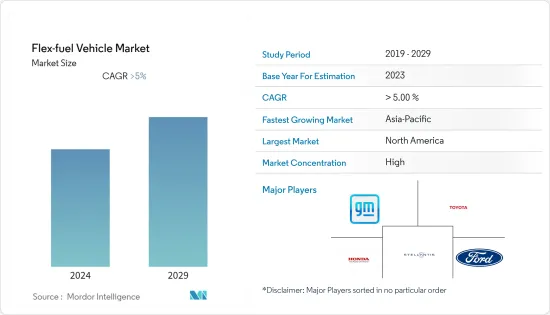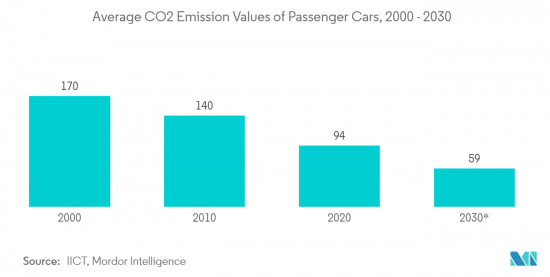 |
市場調查報告書
商品編碼
1406909
靈活燃料汽車 (FFV):市場佔有率分析、產業趨勢/統計、成長預測,2024-2029 年Flex-fuel Vehicle - Market Share Analysis, Industry Trends & Statistics, Growth Forecasts 2024 - 2029 |
||||||
※ 本網頁內容可能與最新版本有所差異。詳細情況請與我們聯繫。
靈活燃料汽車 (FFV) 市場價值 1,040 億美元,預計五年內將達到 1,430 億美元,預測期內複合年成長率超過 5%。

主要亮點
- 靈活燃料汽車(FFV)市場並沒有像其他汽車產業那樣受到嚴重影響。然而,市場上FFV的選擇有限,考慮到世界各國政府實施的法規,銷售量略有下降。然而,隨著局勢的緩和和生活恢復正常,FFV市場預計在預測期內將成長。
- 道路上的大多數汽車都使用傳統石化燃料,導致有害廢氣排放增加。為了遏制汽車污染,一些地級市政府針對配備內燃機的車輛制定了廢氣法規。這些法規為靈活燃料汽車的研究提供了更大的空間。
- 市面上有不同類別和類型的FFV,從E10到E85以上。根據進行的測試,使用 E85 燃料的 FFV 排放量可減少 23% 的氮氧化物、30% 的二氧化碳和 4-6% 的二氧化碳。由於多種因素,包括廢氣排放減少、國內乙醇燃料生產能力以及對天然石化燃料使用的限制等,預計在預測期內,FFV 的需求將會增加。
- 美國和拉丁美洲對彈性燃料汽車的需求正在強勁成長。據估計,全球84%以上的乙醇是在美國和巴西生產的。
彈性燃料汽車市場趨勢
批准嚴格的廢氣法規
- 使用石化燃料的各類車輛的排放不斷增加,污染了空氣。空氣品質惡化導致嚴重呼吸道疾病增加。在歐洲,所有空氣污染中30%以上,包括NOx、VOC、PM2.5、PM10等都是由汽車造成的。
- 為了控制排放,世界各地的機動車管理機構禁止車輛廢氣排放氮氧化物、硫氧化物等溫室氣體和其他有害污染物。
- 例如,在歐洲,廢氣法規逐年嚴格。根據監管機構歐洲環境署(EEA)的數據,2005年小客車實施的Euro4下的NOx標準為0.08g/km,但在2009年降低至0.06g/km。NOx標準沒有變化。
- 同樣,2015年標準小客車二氧化碳排放不得超過130克/公里,但2020年修訂為95克/公里。歐盟委員會還計劃在 2025 年將這一數字降低至 70 克/公里。
- 從長遠來看,減少廢氣中的溫室氣體排放可能會對健康產生重大影響。預計未來幾年靈活燃料市場的需求也會增加,因為與傳統汽油和柴油相比,靈活燃料是更清潔的燃料。

亞太地區實現顯著成長
- 目前,亞太地區70%以上的國家依賴進口石化燃料為其車輛提供動力。原油及其精製成本顯著增加了消費者的燃料成本。在印度和中國等新興市場的推動下,亞太地區預計將顯著成長。
- 例如,在印度,道路運輸和公路部 (MoRTH) 設定了在該國引入乙醇燃料的各種最後期限,以遏制石化燃料消耗並降低燃料成本。此外,印度的彈性燃料產量佔全球的2%,不足以滿足該國的需求。因此,未來幾年國內乙醇產量的目標是從7,000萬公升增加到1.5億公升。
- 運輸部計分類階段擴大乙醇燃料的使用。 E10 計劃於 2022 年 4 月開始生產,E20 計劃於 2025 年開始生產。國內汽車製造商也被通知擴大研究範圍,從2023年4月起允許汽車運行E10,從2025年4月起允許汽車運行E20。
- 由於彈性燃料可以使用甘蔗等可再生原料在國內生產,因此乙醇混合燃料減少了原燃料進口量,有助於降低最終用戶的燃料成本。
- 隨著乙醇基的彈性燃料供應增加,印度這個世界第二人口大國對彈性燃料汽車的需求可能會大幅增加。
Flex燃料汽車產業概況
靈活燃料汽車市場由多家公司組成,形成一個綜合市場。由於使用彈性燃料的產品種類繁多,並且不斷開拓替代燃料,市場上的五家主要企業佔據了重要的市場佔有率。例如,通用汽車公司營運約 13 款車型,福特汽車公司營運 11 款車型,Stallintis NV 營運 7 款使用乙醇混合燃料的車型。
排名前五的公司包括通用汽車公司、福特汽車公司、豐田汽車公司、Stellantis NV、本田汽車工業和現代汽車公司。其他參與者包括日產汽車有限公司、斯巴魯公司和大眾汽車公司。
其他福利:
- Excel 格式的市場預測 (ME) 表
- 3 個月分析師支持
目錄
第1章簡介
- 調查先決條件
- 調查範圍
第2章調查方法
第3章執行摘要
第4章市場動態
- 市場促進因素
- 批准嚴格的廢氣法規
- 市場抑制因素
- 電動車銷量的增加可能是抑制因素
- 波特五力分析
- 供應商的議價能力
- 消費者議價能力
- 新進入者的威脅
- 替代品的威脅
- 競爭公司之間敵對關係的強度
第5章市場區隔
- 乙醇混合型
- E10~E25
- E25~E85
- E85或更高
- 車輛類型
- 小客車
- 商用車
- 汽油種類
- 汽油
- 柴油引擎
- 地區
- 北美洲
- 美國
- 加拿大
- 北美其他地區
- 歐洲
- 德國
- 法國
- 西班牙
- 英國
- 其他歐洲國家
- 亞太地區
- 中國
- 印度
- 韓國
- 日本
- 其他亞太地區
- 世界其他地區
- 南美洲
- 中東/非洲
- 北美洲
第6章 競爭形勢
- 供應商市場佔有率
- 公司簡介
- General Motors
- Toyota Motor Corporation
- Honda Motor Company
- Stellantis NV
- Ford Motor Company
- Hyundai Motor Company
- Nissan Motor Company
- Subaru Corporation
- Volkswagen AG
- BMW AG
- Volvo Car Corporation
第7章 市場機會及未來趨勢

The solid-state battery market was valued at USD 104 billion, and it is expected to reach USD 143 billion over the period of five years, registering a CAGR of over 5% during the forecast period.
Key Highlights
- The market for flex-fuel vehicles (FFV) was not impacted by the COVID-19 pandemic as severely as other automotive industries. However, with limited options for an FFV in the market, it did witness a slight decline in sales, considering the restrictions imposed by the respective governments. However, with the situation easing and life returning to normalcy, the FFV market is anticipated to grow during the projected period.
- Most of the vehicles running are fueled using conventional fossil fuels, which has led to an increase in toxic exhaust gas emissions. To control vehicular pollution, multiple county governments have put forth several emission restrictions for IC (internal combustion) engine-powered vehicles. These restrictions have opened the scope for research on vehicles running on flex fuels.
- In the market, there are various categories and types of FFV from E10 to E85 and above. According to the tests conducted, FFVs running on E85 fuel produce 23% less NOx, 30% less CO, and 4-6% lower CO2. Due to numerous factors, including reduced tailpipe emissions, domestic production capabilities of ethanol-based fuels, and limiting the use of naturally occurring fossil fuels, the demand for FFVs is expected to increase during the forecast period.
- The demand for flex-fuel vehicles is growing significantly in the United States and the Latin American region. It is estimated that more than 84% of the world's ethanol is produced by the United States and Brazil.
Flex-fuel Vehicle Market Trends
Ratification of Stringent Exhaust Emission Regulations
- The increase in vehicle exhaust emissions from all types of vehicles using fossil fuels has contaminated the atmosphere. The poor air quality has led to an increase in a plethora of serious respiratory diseases. In Europe, vehicular pollution contributes to over 30% of total air pollution, including NOx, VOCs, PM2.5, PM10, and others.
- To bring exhaust emissions under control, country-specific vehicle authorities have barricaded the production of greenhouse gasses like NOx, SOx, and other harmful pollutants from vehicle tailpipes.
- For instance, in Europe, exhaust emission norms have become even more strict over the years. According to the regulatory authority European Environmental Agency (EEA), in Euro 4, launched in 2005, the NOx standards were affixed at 0.08g/km, whereas in 2009, it got reduced to 0.06g/km, and it has remained the same for light passenger cars since.
- Similarly, for CO2 emissions in 2015, standard passenger cars were not allowed to exceed 130g/km of CO2. In 2020, it was revised to 95g/km. The European Commission also targets to reduce this number to 70g/km by 2025.
- The reduced amount of greenhouse gases from the exhaust will have a significant impact on health in the long run. Alongside, this will also allow the flex-fuel market to witness an increase in demand in the upcoming years as it is a clean-burning fuel as compared to conventional gasoline or diesel.

Asia-Pacific to Witness Significant Growth
- More than 70% of the countries in the Asia-Pacific region currently rely upon the import of fossil fuels to run vehicles. The cost of crude oil and its refinement significantly increases the consumer cost of fuel. With emerging markets like India and China, the Asia-Pacific region is expected to witness significant growth.
- For instance, in India, to curb the consumption of fossil fuels and tone down fuel costs, MoRTH (Ministry of Road Transport and Highways) has put forward various deadlines to introduce ethanol-based fuel in the country. Additionally, India accounts for 2% of the global flex-fuel production, which is not enough to fulfill the country's requirements. Hence, the domestic production of ethanol is targeted to rise from 70 to 150 million liters in the next few years.
- The transport ministry is planning to roll out the use of ethanol-based fuel in phases. E10 production is expected to be in motion from April 2022 and E20 from 2025. Various vehicle manufacturers in the country have also been notified to scale up the research to run vehicles on E10 from April 2023 and E20 from April 2025.
- As flex fuels can be manufactured domestically using renewable materials like sugar cane, the ethanol-blended fuel will reduce the quantity of raw fuel imported, helping reduce the fuel cost for end users.
- With the increase in the availability of ethanol-based flex-fuel, the demand for flex-fuel vehicles may witness significant growth as India is the world's second-most populated country.
Flex-fuel Vehicle Industry Overview
The flex-fuel vehicle market constitutes various players accounting for a consolidated market. Owing to a wide range of products running on flex fuels and constant developments to find an alternative fuel, the top five players in the market account for a significant market share. For instance, General Motors has about 13 vehicle models, Ford Motor Co. has 11 vehicle models, and Stallintis NV has seven vehicle models running on ethanol blend fuel.
The top five players include General Motors, Ford Motor Co., Toyota Motor Corp., Stellantis NV, Honda Motor Co., and Hyundai Motor Co. Other players include Nissan Motor Company, Subaru Corporation, and Volkswagen AG.
Additional Benefits:
- The market estimate (ME) sheet in Excel format
- 3 months of analyst support
TABLE OF CONTENTS
1 INTRODUCTION
- 1.1 Study Assumptions
- 1.2 Scope of the Study
2 RESEARCH METHODOLOGY
3 EXECUTIVE SUMMARY
4 MARKET DYNAMICS
- 4.1 Market Drivers
- 4.1.1 Ratification of Stringent Exhaust Emission Regulations
- 4.2 Market Restraints
- 4.2.1 Increase Sales of Electric Vehicle May Restraint the Growth of the Market
- 4.3 Porter's Five Forces Analysis
- 4.3.1 Bargaining Power of Suppliers
- 4.3.2 Bargaining Power of Consumers
- 4.3.3 Threat of New Entrants
- 4.3.4 Threat of Substitute Products and Services
- 4.3.5 Intensity of Competitive Rivalry
5 MARKET SEGMENTATION
- 5.1 Ethanol Blend Type
- 5.1.1 E10 to E25
- 5.1.2 E25 to E85
- 5.1.3 E85 and Above
- 5.2 Vehicle Type
- 5.2.1 Passenger Cars
- 5.2.2 Commercial Vehicles
- 5.3 Fuel Type
- 5.3.1 Petrol
- 5.3.2 Diesel
- 5.4 Geography
- 5.4.1 North America
- 5.4.1.1 United States
- 5.4.1.2 Canada
- 5.4.1.3 Rest of North America
- 5.4.2 Europe
- 5.4.2.1 Germany
- 5.4.2.2 France
- 5.4.2.3 Spain
- 5.4.2.4 United Kingdom
- 5.4.2.5 Rest of Europe
- 5.4.3 Asia-Pacific
- 5.4.3.1 China
- 5.4.3.2 India
- 5.4.3.3 South Korea
- 5.4.3.4 Japan
- 5.4.3.5 Rest of Asia-Pacific
- 5.4.4 Rest of the World
- 5.4.4.1 South America
- 5.4.4.2 Middle East and Africa
- 5.4.1 North America
6 COMPETITIVE LANDSCAPE
- 6.1 Vendor Market Share
- 6.2 Company Profiles
- 6.2.1 General Motors
- 6.2.2 Toyota Motor Corporation
- 6.2.3 Honda Motor Company
- 6.2.4 Stellantis NV
- 6.2.5 Ford Motor Company
- 6.2.6 Hyundai Motor Company
- 6.2.7 Nissan Motor Company
- 6.2.8 Subaru Corporation
- 6.2.9 Volkswagen AG
- 6.2.10 BMW AG
- 6.2.11 Volvo Car Corporation








